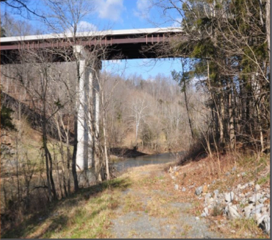By Carolyn Holtzman
Animals making their way between the Allegheny and Blue Ridge mountain ranges have few pathways to safely cross Interstate 81. The Buffalo Creek watershed offers a passage under the highway, and local conservationists are asking landowners to help preserve it.
The valley between the Allegheny and Blue Ridge mountains is split by I-81. Mike Pelton, Rockbridge Area Conservation (RACC) board member, said the division of the land by a busy highway is dangerous because of the animals that regularly cross the valley.

“Thirty to fifty thousand vehicles travel that stretch a day,” Pelton said. “That number is projected to double in the next 30 to 40 years. This poses a serious risk to wildlife and even to people running into these creatures.”
To reduce this risk, conservation groups want to preserve the Buffalo Creek watershed, which creates a safe passage for animals underneath the interstate.
In June 2013, the Valley Conservation Council, a non-profit land trust organization out of Staunton, classified some of the land surrounding Buffalo Creek as one of 10 “Special Project Areas,” meaning the protection of the land is considered especially vital. The Buffalo Creek Special Project Area is about 30 square miles and contains a 20-mile stretch of I-81.
“This is an area that VCC has been focused on for many years because of its ecological significance as a wildlife travel corridor that links the Allegheny and Blue mountains at a point just north of the town of Buchanan and the James River,” Faye Cooper, VCC executive director, said in an email. “The area is a relatively unfragmented forested area, thus providing critical wildlife habitat and a potential passage route for a variety of wildlife from one mountain range to another.”
Pelton said he would like to see fencing along sections of I-81 that would guide traveling animals away from the road and into the Buffalo Creek underpass. Until then, keeping wildlife from crossing the highway depends on preservation of the passage along the creek’s watershed.
The land in the area is privately owned, so the VCC and RACC are encouraging residents to make permanent agreements to prohibit any further development on the land through what are called conservation easements.
“One of our main objectives was to educate people in the corridor area about what we are trying to do, and what they can do if they want to participate voluntarily,” Pelton said. “We asked people to get conservation easements on their land. If they don’t want to do that, then we are trying to teach them how to put in positive conservation efforts of their own.”
Pelton said one way property owners can preserve their land and make it convenient to animals is by letting vegetation grow, preserving streams, and avoiding building on paths wildlife is likely to follow.
Washington and Lee Geology Professor Emeritus Edgar Spencer said the Blue Ridge-Allegheny valley should also be preserved because of its topography.
“The valley is one of the most prominent physiographic features of this part of the world,” Spencer said. “The topography is one of the things that causes so many viewpoints all over the area.”
RACC Board Member Chris Wise said there could also be an economic benefit to land conservation.
“If people are interested in visiting, they could see that there are all these things for them to do like hike and fish in this area,” Wise said. “This could be a way to sell coming to Rockbridge County.”
